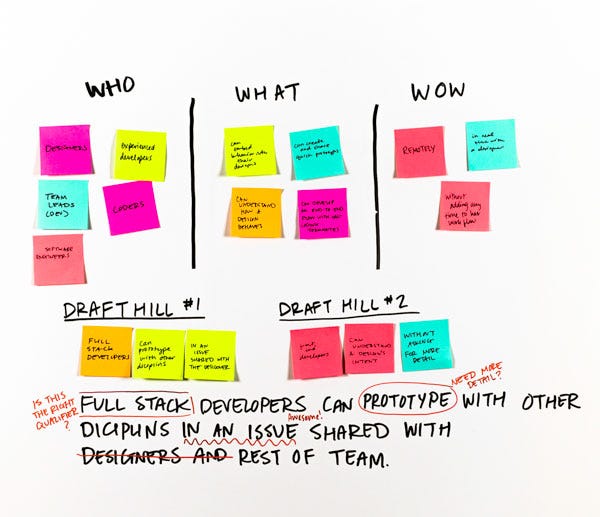Hills: the best framework for determining where to go
I was fortunate enough to attend a wonderful talk by Marion Summerfield at a Product Design event last week. While working at IBM, Marion was part of the team that built and taught design thinking. At the event, Marion introduced the group to the concept of Hills.
What is a Hill? #
A Hill is a statement used to focus a product around the value that it delivers.
Yup. It’s just a single sentence.
It’s not a fancy canvas or chart or a set of tools. It’s just a sentence.
More specifically, that sentence is a statement of intent written as a meaningful user outcome.
Such a statement allows for a product’s desired outcome to be stated with both clarity and flexibility. By framing a problem as an intended outcome for a given user, a team can discover a unique and innovative solution instead of aiming for a predetermined implementation.
So importantly, a Hill isn’t about how to get somewhere, but about where to go.
So, unlike product vision statements, a Hills doesn’t solutionise.
(Compare this to something like Roman Pichler’s Product Vision canvas, which you may be familiar with. In order to craft a vision statement, the Product Vision canvas takes as inputs both a business’s goal and a pre-formed idea about a solution. Hills, by comparison, focus only on the user and their needs.)
Let’s look at an example…
The Moon Landing #
The best example of a Hill is the following statement of intent, made by John F. Kennedy in 1961. JFK vowed that:
We should land a person on the Moon and return them safely back to Earth.
Wow. What an incredible Hill.
Imagine you’re hearing that from the President in 1961. Just, wow. What an outrageously ambitious goal. Landing a spacecraft on the moon is something that’s never been done before, let alone one with people onboard. Moreover, JFK’s not said how they’re going to do it. But he’s saying it’s going to happen.
And — get this — the astronaut is going to be returned safely back to Earth.
Breaking Down The Hill #
Every Hill needs a who, a what and a wow.
We can break down the above example. The who in this Hill is the astronaut. The what is landing them on the moon. The wow is returning them safely back to Earth.
Adding that wow makes this such a monumentally more difficult task. The spacecraft needs to gently descend onto the lunar surface, not crash land. It needs to be able to survive the extreme conditions of re-entry into the Earth’s atmosphere without burning up.
But it’s what gives this Hill that something special. It’s what makes people get goosebumps.
More examples of Hills #
Here are some more tech-focussed examples of Hills. See if you can identify the who, the what and the wow in each.
- Every person in Ireland can use affordable, high-speed internet in their own homes. (Marion’s talk)
- It takes up to a maximum of 30 minutes for a developer to build and run an app using IBM and third party APIs. (IBM Bluemix)
- Our online users can immediately understand the carbon footprint of their ongoing purchase depending on what they’re buying, and how and when they want it delivered, so that they can control their environmental impact. (IBM Garage)
- A sales leader can assemble an agile response team from across her entire corporation in 24 hours, without management involvement. (IBM Designing Thinking Field Guide)
It’s important to note that Hills shouldn’t be static, but should evolve as you increase your understanding of a problem.
Moreover, to focus on a manageable set of goals, make sure that your project has no more than three hills at any given time.
The scope and complexity of the Hill should depend on the timescale involved — if you’ve got a few years, go ambitious (like Kennedy thinking about the coming decade.) If you’ve got a few weeks, go narrow in scope (but still include a wow relative to that scope).
How to write a Hill #
Writing Hills is a collaborative process. Book a room with a whiteboard, get everyone to commit an hour of their time, and grab some packs of post-its.
 From https://www.ibm.com/design/thinking/page/toolkit/activity/writing-hills
From https://www.ibm.com/design/thinking/page/toolkit/activity/writing-hills
On the board, make three columns: WHO, WHAT and WOW. Get everyone to write out post-its for each in silence, using a fixed amount of time for each column (say 5 minutes). Like in any ideation session, here quantity is as important as quality. All ‘bad’ ideas need to get onto paper to allow the good ones to come through.
Remember: you don’t want to think about implementation here. Just focus on the building blocks.
Once these are done, have a go at drafting some Hills, using these building blocks. At first, you can work through quickly to come up with some draft sentences together. Then start slowing it down — keep mixing and matching until you get a sentence that feels right.
Always get as many people involved — once you’ve settled on a Hill, it’s good to get a fresh pair of eyes on it. And remember, the Hills that you come up with aren’t static. They’ll evolve as your understanding of the users and their problems evolve.
How to sell Hills #
You might get pushback if you try and organise a Hill-building session. Not many people have heard of the concept. You might get challenged: can we afford to give up a few hours for this?
But the question is: can you afford not to?
If you’re not focussing on building something that genuinely grants value and equally is ambitious, what’s the point?
It’s just a few hours of your team’s time. So, to borrow Nike’s motto: just do it.
Three bonus tips for a Hill-writing session.
- Send everyone attending your session this article, or the IBM links below, so that they know what they’re doing and the value of doing it.
- Do an ideation warm-up exercise to get everyone thinking creatively. The 30 circles challenge is a good one.
- Bring food! Cake, pizza or a box of chocolates will help to get everyone in the room.
What next? #
Thanks for checking this article out. I hope you can use Hills to your advantage. If you do run a session and create some Hills, I’d love to read them — please drop a comment below with your experience.
I highly recommend downloading and reading the whole IBM Design Thinking Field Guide. You can find more about their framework on their website.
Thanks for reading! Read more articles tagged Design, or check out everything.


